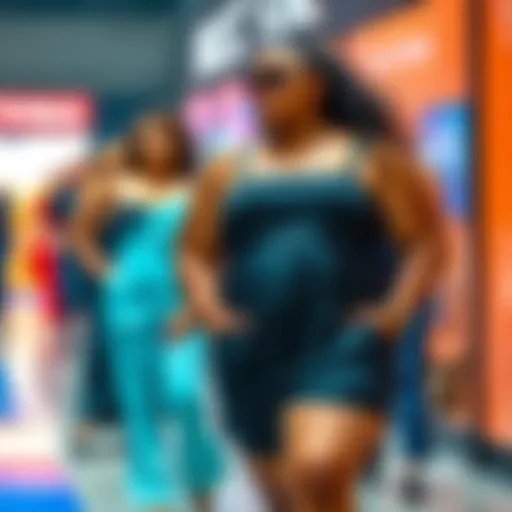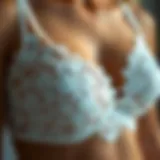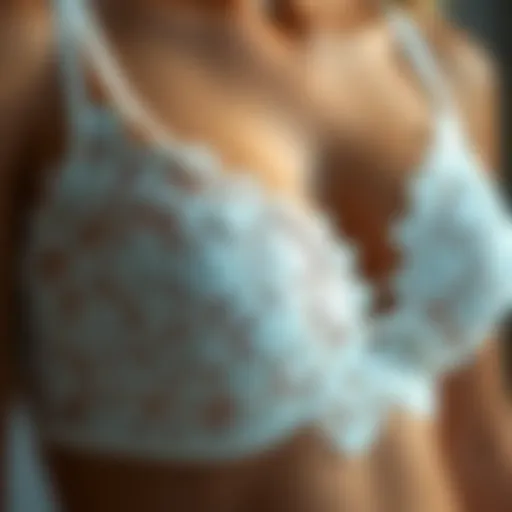Exploring the Functionality of Wig Stands and Mannequin Heads


Intro
In the realm of fashion and personal styling, the humble wig stand paired with a mannequin head holds a unique and significant role. These tools are not merely accessories; they serve as essential instruments for many, whether you are a professional stylist, an enthusiast, or someone looking to express your individuality through various hairstyles. Throughout this article, we will peel back the layers to uncover just how integral these combinations are to the world of fashion and garment care.
Wig stands and mannequin heads are often overlooked in favor of flashier fashion elements, yet they deserve a closer look. They provide functionality and allow users to experiment creatively with hair without the risk of damage. Here, we will explore various aspects of wig stands and mannequin heads, such as their design, materials, and versatility in daily use. Additionally, we will touch on the growing importance of sustainable practices within the fashion industry, illustrating how these elements can contribute to a more eco-friendly lifestyle.
As we embark on this exploration, keep in mind that the intersection of style, functionality, and sustainability is more present today than ever before. From seasonal trends that dictate our choices to eco-conscious practices that shape the industry, understanding these dynamics will enhance our approach to fashion and personal expression.
Intro to Wig Stands
In the world of fashion, the significance of proper styling tools cannot be overstated. Wig stands paired with mannequin heads play a pivotal role, not only in the practical aspects of wig care and styling but also in enhancing creative expression. These tools serve multiple purposes, making them indispensable for both professionals in the industry and individuals who enjoy expressing themselves through wigs.
Definition and Overview
A wig stand is a device designed to hold and support wigs, ensuring they maintain their shape and style when not worn. Mannequin heads, often used alongside these stands, provide a realistic visual aid for styling and presenting wigs. This combination allows individuals to work on their wigs effectively, making it easier to craft intricate hairstyles or apply products, all while keeping the wig in pristine condition.
In recent times, as the popularity of wigs has surged, the demand for high-quality wig stands has also increased. Most stands are crafted with user convenience in mind, offering various designs that accommodate different wig types and user preferences. Some might be adjustable to cater to various heights or styles, while others may come in unique forms that add a bit of flair to any stylist's workspace.
"The right wig stand not only safeguards your investment but also serves as a canvas for your creativity."
Historical Context
The use of wig stands is not a modern invention. Historically, wigs have been a fashion statement, often associated with nobility and theatrical performances. In the 17th and 18th centuries, elaborate wigs were carefully crafted and adorned, necessitating a means for maintaining their shape. Early wig stands were often simple wooden or metal frames, designed to hold these ostentatious styles securely.
As time went on, wig-making evolved and so did the tools associated with it. By the 20th century, the emergence of synthetic wigs brought about an entirely new set of requirements for wig care and styling. The designs of wig stands also advanced, reflecting changes in fashion and techniques. Today, they come in a variety of materials such as plastic, wood, or metal, each serving not just a functional purpose but also catering to aesthetics in a stylist's workspace.
Through the ages, the humble wig stand has quieted the chaos of wig styling, transforming what could be a cumbersome task into a structured and enjoyable process. Thus, understanding these tools is crucial for anyone looking to engage deeply in wig styling, whether for personal use or as a professional pursuit.
Functionality of Mannequin Heads
The functionality of mannequin heads in the realm of wig styling cannot be overstated. It's not just about holding a wig; it's about offering a stable and versatile platform for creative expression. Wig stands paired with mannequin heads serve as essential tools for both professionals and hobbyists alike, allowing for a seamless blend of practicality and artistry. This section explores the vital roles these tools play in the wig styling process, highlighting their multifaceted purposes.
Purpose in Wig Styling
When it comes to wig styling, the purpose of mannequin heads is twofold - they facilitate styling and maintain the integrity of the wig. For those engaged in the hairstyling craft, a mannequin head becomes an extension of artistic vision. Think of it as a blank canvas; it allows stylists to experiment with color, cuts, and textures without the constraint of working on a live model. This is particularly useful during periods of high demand, such as fashion weeks or events, where every second counts.
Moreover, mannequin heads are created to mimic the contours of a human skull. This aspect is crucial as it provides an accurate representation of how a wig will fit and look on a person. The right mannequin head can significantly impact how a wig is styled, allowing for realistic adjustments that improve final outcomes. In this respect, the functionality of these heads not only aids the stylist but also results in a product that will appeal more directly to consumers once it’s ready for their heads.
Features of Mannequin Heads in Wig Styling:
- Versatility: Can be used for different styles and lengths of wigs; from straight to curly.
- Durability: Made from materials that withstand multiple styling processes, providing longevity.
- Compatibility: Various sizes available to accommodate different wig cap sizes, thus enhancing adaptability.
Visual Presentation
The visual presentation is another critical function of mannequin heads that cannot be overlooked. When it comes to marketing wigs or showcasing a specific hairstyle, presentation is key. A well-styled wig displayed on a mannequin head can make a compelling visual impact. This is particularly useful in situations like fashion shows, beauty salons, or even e-commerce sites where first impressions count for everything.
Using mannequin heads, stylists can curate looks that highlight the key features of a wig. For instance, the alignment of the wig with the natural fall of hair plays a significant role in how it is perceived by potential buyers. This attention to detail in presentation creates a lifelike appearance that encourages consumer purchase decisions.
"A striking presentation can elevate a simple wig into a coveted piece of fashion."
In addition to sales contexts, mannequin heads also facilitate educational opportunities. For aspiring hairstylists, these tools provide a real-world aspect to their training. Students can learn how light interacts with different hairstyles, or how to manipulate wig fibers in a way that enhances overall aesthetics.
In summary, mannequin heads are not just devices for securing wigs; they bring a creative dimension to styling. Understanding their functionality shifts the perspective from viewing them merely as tools to appreciating them as platforms for artistry and commerce alike. With the right mannequin head, the possibilities for styling are virtually limitless.
Types of Wig Stands
In the intricate world of wig styling, the choice of wig stand plays a pivotal role in both the application and maintenance of wigs. These stands not only offer practical support but also enhance the styling process itself. With various options available in the market, understanding the types of wig stands can significantly improve your hairstyling experience. Each type has its own unique advantages, depending on the specific needs and preferences of the user. Whether you're a professional stylist or simply an enthusiast, knowing the different types of stands can make a world of difference.
Tripod Stands
Tripod stands are among the most common choices, especially for those who value stability and portability. Constructed with three legs, these stands often provide a solid base, ensuring that your wig remains secure while you work on it. This type of stand is ideal for those who may be moving around a lot or need to adjust the height frequently.
Among the benefits of tripod stands:
- Adjustable Height: Many models allow for easy height adjustments, helping accommodate various working environments and individual styles.
- Portability: Lightweight and collapsible options make them convenient for travel, perfect for stylists on the go.
- Versatility: They are suitable for various wig types and can be used for both styling and display.
However, it’s important to choose one with a sturdy construction, as flimsy designs can lead to tipping or wobbling, which might spell trouble during intricate styling tasks.
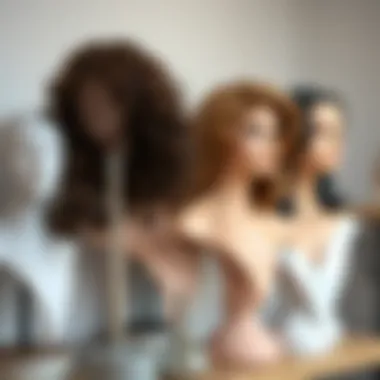
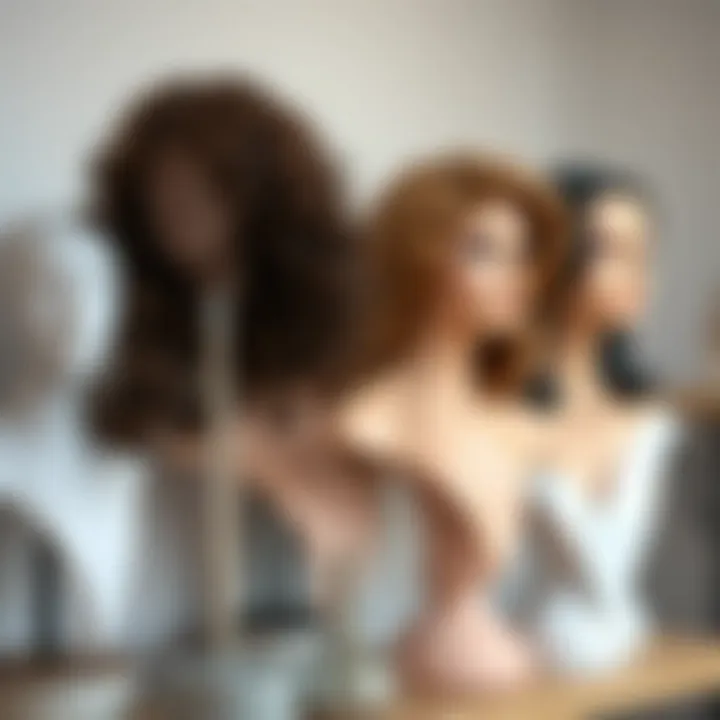
Adjustable Stands
Adjustable stands cater to those who require a bit more flexibility in their styling routine. These stands are characterized by mechanisms that allow you to customize the height and sometimes the angle of the mannequin head. This feature is especially beneficial for precision styling or when working with wigs of varying lengths and styles.
Key points about adjustable stands include:
- Customization: Users can modify the height according to their needs, ensuring comfort during styling.
- Enhanced Control: The option to tilt the head can help achieve specific styling angles that aid intricate styling techniques.
- Stability: Many adjustable models boast a robust base that reduces the risk of the stand shifting or collapsing during use.
Though the added features might come with a higher price tag, the investment usually pays off in the form of improved styling results and enhanced comfort.
Wall-Mounted Options
For those with limited space or a desire for a more permanent styling fixture, wall-mounted options offer an ingenious solution. These stands are secured to the wall, providing a fixed point from which to style wigs. This type can be particularly advantageous in studios or in homes where counter space is at a premium.
Advantages of wall-mounted wig stands include:
- Space-Saving: They free up floor space, making them perfect for smaller areas while still being accessible for styling.
- Stability: Being attached to the wall, they often provide a very stable platform and can handle more weight without the risk of tipping.
- Ready Access: Once installed, they can be easily accessed, allowing for quick styling sessions without the hassle of setting up and taking down equipment.
It's wise to ensure that the wall-mounted stand is professionally installed to avoid any issues with sturdiness.
In summary, the type of wig stand chosen can affect the ease and effectiveness of the styling process. Whether you opt for the flexible tripod, the customizable adjustable stand, or the convenient wall-mounted option, understanding their unique characteristics is imperative for anyone serious about wig styling. Emphasizing the stand's role, one can significantly improve both the personal and professional styling experiences.
Materials Utilized
Wig stands are not just a mere accessory for storing wigs; they play a crucial role in the maintenance and styling of this essential fashion item. The materials used in constructing these stands directly influence their functionality, durability, and overall aesthetic appeal. Selecting the right material for a wig stand can significantly impact how well it holds and showcases wigs, catering to the specific needs of designers and consumers alike. Here, we delve into three main types of materials utilized in wig stands: plastic, wood, and metal. Each material comes with its own set of advantages and considerations, making it vital for users to understand their options.
Plastic Stands
Plastic stands are among the most common choices in the market. Their lightweight nature and ease of transport make them particularly attractive for people who frequently travel or attend events. One of the most significant advantages of plastic stands is their affordability. Unlike wooden or metal options, plastic stands are usually available at lower price points, making them accessible to a broader audience.
Moreover, plastic stands come in a variety of colors and designs, giving users the option to select a product that fits their personal style or brand identity. However, it’s essential to consider the durability aspect; while some high-quality plastic stands can be quite sturdy, they may not always withstand heavy use. If someone is handling wigs frequently, particularly in a professional context, they might find plastic stands less reliable than other materials.
Wooden Bases
Wooden wig stands exude a classic and sophisticated charm. The natural grain and finish of wood not only provide a timeless aesthetic but also ensure a level of sturdiness often unmatched by plastic alternatives. Many stylists and designers prefer wooden bases for their ability to stabilize wigs, especially when styled intricately. The weight of a wooden stand often contributes to its ability to prevent wig slipping or falling, which can be critical when presenting intricate styles.
Additionally, wooden stands have a certain warmth to them, which can enhance the visual presentation of wigs during displays or fashion shoots. When caring for wooden stands, users should consider maintenance to prevent warping or cracking, particularly in varying humidity or temperature conditions. Oil treatments or specialized wooden care products can keep these stands in tip-top shape, ensuring they last for years.
Metal Constructs
Metal wig stands represent the pinnacle of durability and robustness. Constructed from materials like aluminum or stainless steel, they offer unmatched stability, making them ideal for both professional and at-home use. Metal stands often feature adjustable heights and configurations, catering to specific styling needs.
Another perk of metal constructs is their aesthetic appeal for modern or industrial-themed settings. They come in sleek designs that communicate sophistication and strength. However, some users might find them on the pricier side. Their longevity, however, often justifies the initial investment, as they typically withstand wear and tear far better than their plastic or even wooden counterparts.
Choosing the Right Wig Stand
Selecting the appropriate wig stand is more than just picking something off the shelf. The right choice influences how well your wig is maintained, styled, and ultimately, how it looks when worn. It’s about ensuring that your creative visions come to life without the hiccups of poor tools. Moreover, from the perspective of both amateurs and professionals within the fashion sphere, the right stand can make the difference between a flawless presentation and a disheveled look. Let’s deep dive into what factors contribute to this important decision.
Factors to Consider
Weight and Stability
When it comes to wig stands, weight and stability are your best friends. A stand that’s too lightweight may topple over with the slightest breeze, while one that’s heavier often provides firmness, ensuring your wig maintains its shape and style during any handling. Think of it as a sturdy foundation; without it, everything stands to crumble. A stand with good stability keeps your mannequin head upright, especially paramount when styling intricate designs that require finesse.
However, it’s not just about weight alone. Consider how the distribution of that weight affects the overall balance. If you’re working with particularly elaborate or heavy wigs, opting for a stand designed to handle such demands is essential. This characteristic leaves you with less worry and more time to create a masterpiece. Sometimes, heavier stands are designed with weighted bases that might be a bit cumbersome to carry around, but their reliability compensates for that inconvenience.
Height Adjustability
Height adjustability is another significant factor that shouldn’t slip under the radar. It directly affects your ergonomics while you're styling. Being able to adjust the stand height means you can work without straining your back or neck, which is vital for extended periods of styling. Plus, it aligns the mannequin head at your eye level, making it easier for you to execute precise styles without constantly bending over.
The versatility offered by height adjustability is appealing whether you're working in a salon or at home. It equips you to tailor the stand to suit various wig styles and user preferences. However, one must keep in mind that while some stands offer this feature, they can sometimes be less stable due to moving parts. Assessing how often you'll be using the height adjustment feature could inform your ranking of its importance.
Material Durability
Last but not least, material durability plays a pivotal role in your decision-making. Nobody wants a stand that buckles under the pressure of a well-styled wig. Invest in materials that can withstand daily wear and tear. For instance, polycarbonate stands are robust yet lightweight, ensuring longevity while being easy to handle. On the other hand, wooden stands exude elegance but might not be as resilient against moisture or handling.
The choice of material is interlinked with the permanence of your investment. For those who plan to use their wig stand regularly, going for a material that holds up against regular manipulation makes more sense. Plus, certain materials can be prone to scratches or dents, which could impact your styling. Consider this as you weigh your options; durability today might save you frustrations in the future.
Best Practices for Selection


Choosing your wig stand isn’t a decision to take lightly. Here are some best practices when it comes to making your selection:
- Know Your Needs: Tailor your choice based on how you intend to use the wig stand. Are you a stylist working on multiple wigs or a casual user?
- Research Options: Look up user reviews and expert opinions. Websites like Reddit can provide honest feedback.
- Test Stability: If possible, try out different stands to see how solid they feel. Getting a hands-on experience tells you a lot.
- Consider Storage: If space is tight, consider stands that are foldable or compact.
Wig Stand Maintenance
Caring for a wig stand may not be the first thing on a stylist's or enthusiast's mind, but it plays a pivotal role in ensuring both the longevity of the stand and the overall appearance of the wigs displayed on it. Proper maintenance becomes increasingly important when you consider the various elements that come into play in the life of a wig stand and mannequin head.
Cleaning Techniques
When it comes to cleansing a wig stand, the goal is to keep it free from dust, oils, and other residues that can accumulate over time. Here are some effective strategies for maintaining a clean and hygienic stand:
- Gentle Wipe Down: Use a soft, damp cloth to wipe down the stand. This helps in collecting the dust without scratching the surface. Make sure to use a cloth that doesn’t leave behind fibers.
- Soap and Water Mixture: For deeper cleaning, mix mild soap with lukewarm water. Dampen your cloth with this solution and carefully wipe the stand. Avoid saturating the stand, especially if it’s made from materials like wood or metal.
- Avoid Harsh Chemicals: Stick to natural cleaning products whenever possible, as harsh chemicals can damage the finish or integrity of the stand. This is particularly vital for stands crafted from sensitive materials.
- Regular Routine: Set a cleaning schedule for your wig stand. Depending on the frequency of usage, cleaning it bi-weekly or monthly can prevent dirt build-up and maintain its aesthetics.
An effective cleaning routine keeps the stand looking fresh and also has the added benefit of making sure that any wigs placed on it don‘t pick up odors or dirt.
Storage Tips
How a wig stand is stored can significantly influence its lifespan and effectiveness. Here are some practical storage tips:
- Keep It Dry: Always store your wig stand in a dry environment. Moisture can lead to mold and mildew, especially in wooden stands. Make sure the storage area is ventilated.
- Avoid Direct Sunlight: Sunlight can fade the colors of both the stand and the wigs. If possible, store your stand in a shaded area or inside a box to protect it from UV damage.
- Disassemble if Possible: If you have a tripod or adjustable stand, taking it apart can save space and also reduce the risk of it getting accidentally knocked over. Store the pieces securely together to avoid misplacing them.
- Utilize Protective Covers: Use covers designed for wig stands or mannequin heads to keep them dust-free during storage. This is simple yet effective in preserving the quality of the stand.
- Strategic Placement: Store your wig stands in a place where they will not be bumped or moved frequently. An area where the risk of impact is minimal ensures they remain intact and functional.
The way you maintain your wig stand not only reflects your personal care standards but also affects the wigs you style. A clean, properly stored wig stand creates an environment where creativity can flourish, promoting efficiency in styling.
Implementing these maintenance strategies can help you maximize the life of your wig stand, allowing you to focus on what truly matters – creating stunning hairstyles and making fashion statements that last.
Enhancing Styling with Wig Stands
The use of wig stands with mannequin heads has become an integral part of modern hairstyling, offering a wealth of possibilities for fashion enthusiasts and professionals alike. They allow for precision in styling, ensuring that the user can manipulate hair without the constraints that often come with styling on a moving head. This section delves into the intricate details of enhancing styling with wig stands, emphasizing how they can transform the way wigs are prepared and presented.
Techniques for Styling
Mastering hairstyling techniques is crucial when working with wig stands. Here are some techniques that can elevate styling:
- Sectioning the Hair: Dividing the wig into manageable sections aids in thorough styling. Employing clips can help hold sections in place.
- Using Heat Tools: When applying heat, materials like synthetic hair react differently than natural hair. Knowing how much heat each type can handle is vital to prevent damage.
- Practice Makes Perfect: Each stylist has their unique methods. Regular practice on a mannequin head allows stylists to refine their skills, ensuring flawless results.
"Using a wig stand isn't just about holding the hair; it’s about giving you that extra pair of hands you need for perfect results."
Displaying Hairstyles
Once the hairstyling is complete, showcasing these styles on wig stands becomes an essential part of the process. Here are some considerations when displaying hairstyles:
- Lighting: Proper lighting can significantly affect how a hairstyle is perceived. Natural light can showcase details better, while soft artificial light can add an appealing glow.
- Background Choices: A clean, uncluttered background accentuates the hairstyle. Choosing neutral tones or complementary colors can enhance visibility without stealing the spotlight.
- Height and Angle: Adjusting the mannequin stand's height and angles ensures the best visual impact. Different angles unveil different aspects of the hair, adding depth and character.
Understanding how to effectively enhance styling with wig stands not only improves the end result but also boosts the confidence of those working in fashion, making it an indispensable tool in any stylist's arsenal.
Creative Uses for Mannequin Heads
Mannequin heads, often overlooked as mere displays, hold a significant place in the world of fashion and personal styling. The creative potential of these tools transcends basic wig storage, offering unique applications that serve both professionals and enthusiasts alike. Recognizing the value of mannequin heads fosters a deeper appreciation for their versatility in enhancing not only wearable art but also personal expression.
Fashion Photography
In the realm of fashion photography, mannequin heads breathe life into static concepts. Photographers utilize these heads to showcase wigs or headpieces in a way that emphasizes the craftsmanship and artistry involved in styling. Rather than focusing solely on live models, which can be unpredictable at times, a mannequin head provides a reliable canvas where every strand and texture can be perfectly captured.
The distinct angles of mannequin heads allow for a variety of shooting perspectives. Photographers can capture a close-up of intricate beading on a wig or experiment with creative lighting to highlight the sheen of the fibers. This practice not only showcases the product in its best light but also enables a controlled environment, ensuring that each shot delivers precision and clarity.
Moreover, using mannequin heads in fashion campaigns adds another layer of narrative. They can evoke emotion or even tell a story through visual elements such as placement, props, and accompanying apparel. A head adorned with an avant-garde wig can imply a bold statement about individualism and artistic expression—qualities that resonate deeply with fashion audiences.
Artistic Displays
Mannequin heads also find a place in artistic displays, becoming integral pieces in exhibitions and gallery spaces. Artists and designers work with these forms to create striking visuals that challenge traditional art forms. By incorporating wigs and different styling techniques, they push boundaries, transforming a simple mannequin head into a dynamic piece of art.
The appeal of mannequin heads in artistic displays lies in their adaptability. They can be painted, adorned with various materials, or styled in avant-garde fashions, creating conversation starters that engage viewers. For instance, a mannequin head painted with bright colors, adorned with natural elements like flowers, or abstract designs can become a focal point of an exhibit, prompting viewers to reflect on themes of identity and transformation.
In these creative setups, the mannequin head serves not just as a container for style but also as a medium for storytelling. It invites observers to contemplate how art can be influenced by fashion and vice versa.
These artistic dimensions highlight the importance of mannequin heads beyond their original purpose. They are not merely tools for display; they are canvases for creative exploration that fuel innovation in design and photography.
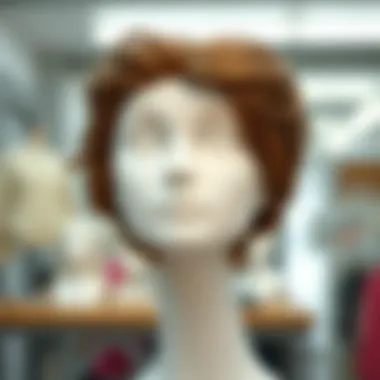
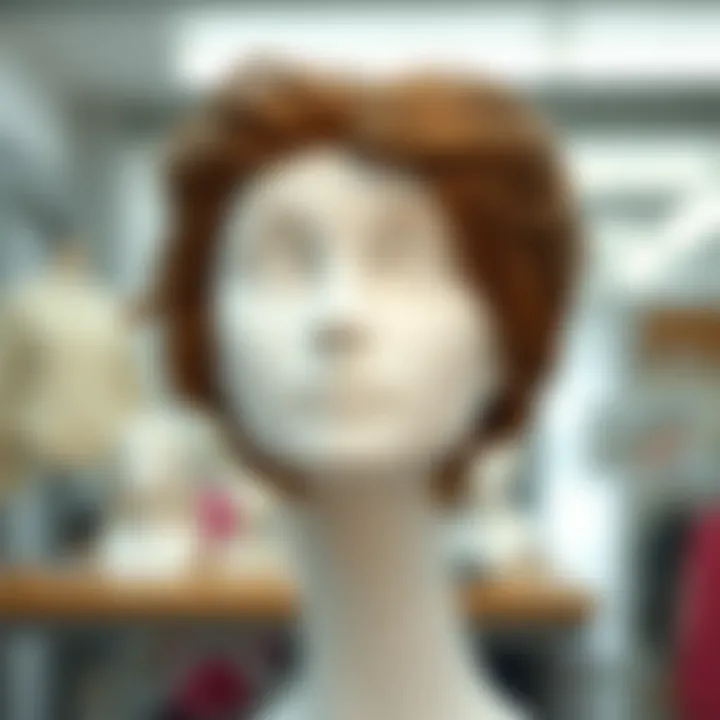
"The beauty of a mannequin head lies in its ability to transcend mere utility—becoming a medium for both expression and artistry."
Exploring these avenues of utilization enhances the appreciation for mannequin heads in today's sophisticated fashion landscape, emphasizing their significance as more than simple supports for wigs.
Sustainability in Wig Styling
Sustainability has emerged as a fundamental aspect in various industries, including fashion, and it’s gradually making its mark in wig styling as well. As more individuals and professionals become eco-conscious, the need for sustainable practices within this niche is increasingly recognized. Choosing sustainable materials and practices not only helps to protect the environment but also promotes a more responsible approach to styling and care.
The use of eco-friendly wig stands and mannequin heads supports this initiative by reducing the carbon footprint associated with wig styling. By prioritizing sustainability, designers and consumers alike can contribute to a more ethical fashion industry.
Eco-Friendly Materials
When it comes to wig styling, opting for eco-friendly materials is essential. Many wig stands are now made from biodegradable plastics, sustainably sourced wood, or even recycled metals. This shift towards using greener materials doesn’t just appeal to the environmentally conscious; it also provides durability with a lower environmental impact.
For instance, biodegradable plastics are designed to break down more easily in natural environments as compared to conventional plastics. They still offer plenty of the necessary support and stability needed for wig styling, thus ensuring that beautifying your looks doesn’t come at the earth's expense. Similarly, wooden wig stands not only boast a classic aesthetic but when crafted from sustainably sourced timber, they align with eco-friendly practices. This option not only proves functional but artful, adding an element of charm to any styling setup.
"Switching to eco-friendly materials is not just about responsibility; it is about creativity that does not compromise our planet's health."
Second-Hand Options
Embracing second-hand options for wig stands and mannequin heads can significantly contribute to sustainability in wig styling. By purchasing used products, consumers help to minimize waste and reduce the demand for new production. This practice embodies the recycling ethos—extending the life cycle of existing products, and consequently, lowering the overall environmental impact.
Finding second-hand wig stands may involve sifting through thrift stores, online marketplaces, or even local salons looking to offload used equipment. Engaging with community groups or platforms like Reddit for recommendations can also unveil hidden gems. Not only does it often save money, but it fosters a sense of creativity in reinventing and customizing these items.
Expert Opinions and Insights
The realm of wig stands and mannequin heads extends beyond mere functionality; it delves into the very fabric of fashion and design. Hearing directly from those who navigate this dynamic field, we gain valuable perspectives. Expert opinions are not just insights; they serve as a bridge connecting theory and practice.
Expert advisors, stylists, and designers often express how paramount these tools are for creative expression and technical precision. They act as a solid foundation for building and showcasing hairstyles that meet both personal and professional standards. The dialogue surrounding this topic reveals several key elements, encompassing aesthetic appeal, practical utility, and even the psychological comfort that a well-designed stand can offer.
Interviews with Stylists
When it comes to interviewing professionals in the wig styling industry, the enthusiasm is palpable. Many stylists emphasize that a quality mannequin head can hugely influence their work. For instance, some stylists have shared that using a mannequin head mimicking a human’s facial structure offers not only realism but also inspires creativity in how wigs are styled and presented. It becomes a canvas where innovation meets practicality.
Consider the insights of renowned stylist Maria Rodriguez, who notes:
"Investing in a good mannequin head is vital. It's like having a solid partner in crime. If I want to create a wild, avant-garde look, knowing that the foundation can handle the weight of my artistry is key."
It's interesting to hear consistent themes in interviews, where stylists point out the need for durability and adjustability. Striking flexibility in adjusting the heights, coupled with stability, allows them to experiment without constant worry about their setup failing mid-creation.
Case Studies
Examining case studies further lends credence to the assertions made by stylists. One notable example involves a local salon who decided to invest in a set of high-end mannequin heads—each tailored for specific wig types. The feedback was astounding. They noted a 30% increase in customer satisfaction after introducing these new styling tools.
Additionally, many stylists report transformation stories. Stylist James Parker utilized a tripod wig stand during a fashion show, which enabled him not just to display but also to actively customize wigs during the event. As a result, audience engagement peaked, and he secured several contracts from attendees impressed by the interactive showcasing.
- These case studies underpin how critical expert insights can be. They are less about numbers and more about the real-world implications on style, engagement, and overall satisfaction.
The marriage of expert opinion and tangible results paints a rich tapestry that highlights the nuance of wig stands and mannequin heads in the fashion narrative. Such tools are not just accessories; they are fundamental elements driving innovation, satisfaction, and artistic expression. Ultimately, insights from stylists weave a compelling story about their pivotal role in the fashion ecosystem.
The End: The Importance of Wig Stands
When it comes to the realm of hairstyling, wig stands equipped with mannequin heads might seem like mere accessories, yet their significance runs deep in both utility and artistry. Understanding their importance is key not just for professionals but also for fashion enthusiasts who wish to elevate their styling game.
Wig stands do more than simply hold wigs; they serve as essential tools for creating, maintaining, and presenting hairstyles with flair. A sturdy wig stand ensures that styles are formed accurately, allowing for creativity to flourish without the worry of messy tangles or improper fit. Furthermore, they play a crucial role in preserving the longevity of wigs, shielding them from heat and environmental wear when not in use. For those involved in fashion photography or stage performances, they offer a reliable way to display the finished product.
As explored in the previous sections, wig stands come in various designs—from tripod to wall-mounted options—each tailored for specific needs. Each type brings its own set of advantages, whether it be portability or adaptability, but the common thread is their shared function: enhancing styling efficiency and outcome. This makes selecting the right stand essential for achieving the desired results.
"A well-chosen wig stand is like a well-chosen canvas for an artist—it provides the right setting to unleash creativity.”
Beyond functionality, the aesthetic aspect of mannequin heads cannot be overlooked. They offer a way to visualize hairstyles before wearing them. Their role in fashion events and displays adds depth to the stylistic narrative being presented. Additionally, the intersection of sustainability with wig stands and mannequin heads highlights a growing trend towards eco-conscious choices in fashion. This opens up possibilities for collaboration with companies that prioritize sustainable materials, inviting a renewed appreciation for both beauty and responsibility in styling.
Ultimately, recognizing the importance of wig stands is about more than their concrete benefits; they symbolize the meticulous craftsmanship that goes into the world of styling. By enhancing the ease of wig care, expanding creative possibilities, and promoting sustainable practices, wig stands represent an essential component of the fashion ecosystem.
Recapitulation of Key Points
- Utility and Preservation: Wig stands secure wigs, helping to maintain their shape and integrity.
- Variety Matters: Different types of stands cater to unique needs—from mobility to static displays.
- Art and Presentation: They assist in displaying hairstyles in an appealing manner, which is vital for both personal styling and professional showcases.
- Sustainability: The trend towards eco-friendly materials in wig stands reflects a broader movement in fashion towards more responsible consumption.
Future Trends in Mannequin Heads and Wig Stands
Looking ahead, one can anticipate a few notable trends in the domain of wig stands and mannequin heads. The integration of technology plays a significant role in transforming how these accessories are designed and utilized. For instance, smart mannequin heads equipped with sensors could provide real-time feedback on how wigs look under various lighting, aiding in better color matching and styling decisions.
Moreover, the push for eco-friendliness will likely amplify. Expect manufacturers to further innovate in the use of biodegradable materials and sustainable production practices. This could reshape the market, inviting designers and users to contribute to a more environmentally-friendly fashion future while still enjoying the benefits of high-quality wig displays.
Lastly, customization could gain traction—allowing consumers to choose colors, materials, and designs that best suit their personal aesthetics. This trend could make wig stands not just tools but also unique expression pieces in their own right, uniting functionality with personalized art.





